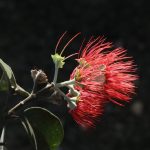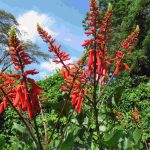TREE LIFE
JANUARY 2023
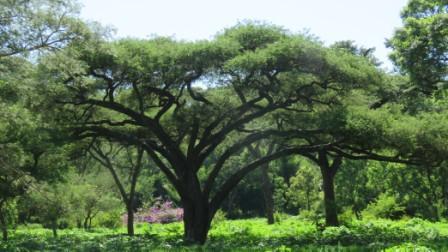
Acacia sieberiana Photo by Rob Jarvis
Hi Everyone,
The rains are truly with us and I am sure everyone is enjoying the rich diversity of life that the summer season brings to our homes, gardens, farms and public places. There is no more iconically shaped outline in the African landscape than that of one of the flat-topped acacias. The one above is A. sieberiana and can be found in plentiful numbers in and around Harare and in fact across the length and breadth of Zimbabwe. Their presence is usually marked by swards of rich green grass underneath and even in the cold depths of winter, an A. sieberiana in an irrigated pasture will still be green with grass underfoot when frost has browned off all the exposed grass outside its ambit. They are well-adapted, grow quickly and really look the part in our landscape. If you are tempted to go into planting mode in the second half of this summer, consider the acacias.
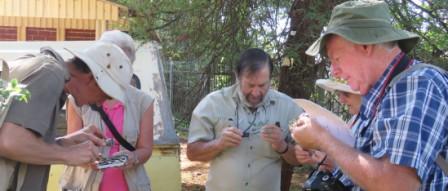
Looking for glands Photo by Jim Dryburgh
National Botanical Garden Outing 3rd December 2022
By Tony Alegria
On a bright sunny morning the following ladies were present: Mary Lovemore, Meg Coates Palgrave, Frances Morris, Sarah Roberts, Anne Sinclair and Barbara Dean. And the men: Mark Hyde, Jim Dryburgh, Jan van Bel, Peter Morris, Peter Dean, Rob Jarvis, Ryan Truscott, Karl van Laeren, Tony Alegria and Arthur Mavhimba from WildAid.
The mission for the day was twofold – to see which Acacias could be recognized from a distance and what features were diagnostic close up. We started by looking at the acacias in the car park as there were two trees I hadn’t seen anywhere else within the National Botanical Garden. Although there were the odd flower here and there, flowers were not looked at as part of the outing. Below is the order of trees we looked at.
Acacia karroo Sweet thorn is recognizable from afar by its very dark looking branches and curved pods. Close by, there are between 2 & 5 pairs of pinnae with fairly large leaflets for an acacia. Leaflets are apart with gaps in between them. Leaflets were spatula shaped with the two terminal ones more rounded looking like Mickey Mouse ears. We looked at the glands (extra -floral nectaries) but didn’t find them to be diagnostic on the trees we looked at.
Acacia abyssinica Nyanga flat-top has many dry twiggy branches under the canopy. The leaf is about four times longer than its width. Has many pairs of pinnae each with many small leaflets.
Acacia polyacantha White-stem acacia has whitish looking branches and big leaves, the leaf is about twice the length of its width. Has many pairs of pinnae each with many small leaflets, many straight looking pods and a few scattered knob thorns.
Acacia sieberiana Paperbark acacia has the largest pods of the acacias and as with Acacia abyssinica and Acacia galpinii can have flaky, corky bark. The leaf is about three times the length of its width and has many pairs of pinnae each with many small leaflets.
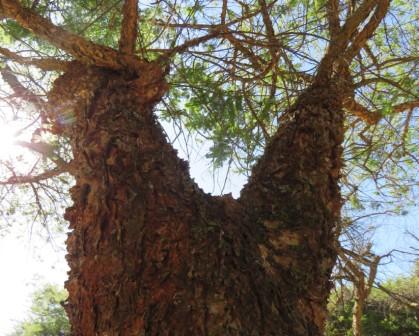
Very Knobby Knobthorn Photo by Jim Dryburgh
Acacia nigrescens Knob thorn has the most obvious feature being its many knob thorns. They have very few pairs of pinnae with only a couple of large leaflets each. The leaflets are large for an acacia but tiny for most trees!
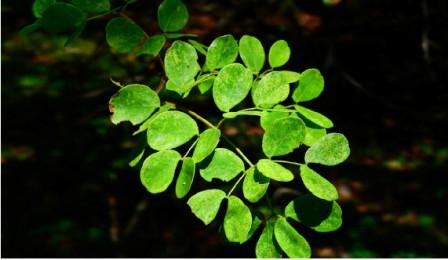
Acacia nigrescens Photo by Jim Dryburgh
Nearby was an Acacia rehmanniana. Silky acacia distinguished from afar by its reddish branches and small leaves with tiny soft leaflets.
Acacia galpinii. Monkey acacia is a big tree with large leaves with many pinnae and small leaflets. Can have flaky corky bark but the one we looked at had vertical fissures and scattered knob thorns.
The last acacia we had a look at was the Acacia goetzei. Purple-pod acacia with large leaves but only 3-10 pairs of pinnae and about 10 pairs of large leaflets. The leaflets are not nearly as big as those of the Knob thorn. We also looked at glands on some Albizias and the Newtonia buchananii.
Editor’s comment we had two contributions to the Newsletter for the walk on 3rd December 2022 and rather than take one and not the other we decided to accept both and hopefully members can glean useful information form these two experts. You have read Tony Alegria’s on the preceding page and below is Mark Hyde’s more specific commentary on the glands to be found on acacias and other mimosoids.
Glands in Acacia (Botanic Garden Walk: 3 December 2022)
By Mark Hyde
There was a good turnout of 16 people in the carpark of the Botanic Gardens on a bright sunny summer’s morning.
One of the objectives which had been chosen by Tony, was to examine the glands on the leaves of species of Acacia in order to establish if the shape, location and size of the glands was useful in naming acacias.
Meg opened the discussion by observing that these glands are extra-floral nectaries. They secrete a sugary liquid (nectar) which attracts insects such as ants. In return the ants vigorously defend the tree when being browsed by animals. The paper cited below [1] describes how ants are able to distinguish between vibrations caused by browsers and those induced by wind and respond quickly to the attacks.
Before looking at individual species, some generalisations are possible. The glands are mostly ring-shaped with a central hollow. They occur on the upper side of the leaf only. They are sometimes raised up above the rhachis and in some species (not in acacias but in the case of Newtonia buchananii and Dichrostachys cinerea) on long stalks. The size of the central hollow varies. The glands often sit in the channelled upper side of the rhachis.
All of the species we looked at had 2-pinnate leaves. In general, the pinnae are arranged opposite one another on the rhachis and in general the leaflets are also opposite along the pinna rhachis, so we can refer to pinna-pairs and leaflet-pairs. However, I was surprised at how often they were not exactly aligned.
The glands may occur:
On the petiole;
On the leaf rhachis (almost always between a pinna-pair);
On the pinna rhachis (almost always between a leaflet-pair).
We started with Acacia karroo. This has up to 5 pairs of pinnae; on this tree in the carpark, there were mostly 3 pairs and glands occurred on the rhachis between all of the pinna-pairs. There were none on the petiole nor amongst the leaflets.
Acacia abyssinica. This had one gland between the 2 basal pair of pinnae; no other glands were seen.
Acacia polyacantha has numerous pairs of pinnae (15 or more per Meg). This species has a distinctive, large gland on the petiole and in addition, there were also glands between the top 3-4 pinna-pairs; the number was variable among different leaves on the same tree. Meg remarked that the glands were often not to be found in the middle of each leaf and this was demonstrated by this species and also rehmanniana, and schweinfurthii and to some extent galpinii and goetzei.
Acacia nigrescens has 2-4 pairs of pinnae, each with only 1-2 pairs of leaflets. In contrast to the large leaflets, the glands appeared to be very small. Each leaf had a tiny gland about halfway up the petiole, in general none between the pinnae (one leaf was found with a gland between the terminal pair) but with glands between the uppermost leaflet-pair. There was noticeable variation in the pattern from leaf to leaf.
Acacia rehmanniana had a gland on the petiole just below the lowest pair of pinnae also amongst the top 4-5 pinna-pairs.
Acacia galpinii had a gland on the petiole and sometimes a gland between the upper 2 pinna-pairs, sometimes none.
Acacia goetzei subsp. goetzei had very variable arrangement of glands. There was a gland about 1/3rd of the way up the petiole, sometimes one between the terminal pinna-pair and then erratically between the pairs of leaflets with no particular pattern.
Finally, Acacia schweinfurthii. This has a gland low down on the petiole and also a gland between the upper pinna-pair. The position of the petiolar gland helps to separate this species from Acacia ataxacantha. The gland is less than ¼ of the way up the petiole in schweinfurthii and more than ¼ and sometimes more than ½ in ataxacantha.
We also looked at some examples of other mimosoid genera.
In the case of Albizia, Tom Muller always used to say the position of the gland on the petiole was a diagnostic character.
Albizia anthelmintica – gland at the top of the petiole and between or slightly below the terminal pinna-pair.
Albizia harveyi – petiolar gland halfway up the petiole and between the terminal pinna-pair.
Albizia versicolor – petiolar gland 1/3 to ½ of the way up the petiole and very variable on the rhachis.
Amblygonocarpus andongensis – no glands at all.
Leucaena leucocephala – no glands at all.
Newtonia buchananii – erect stalked glands between all pinnae-pairs.
Xylia torreana – this has only one pair of pinnae. There was a gland between that pinna-pair and also generally between each leaflet-pair.
CONCLUSIONS
There is considerable variation in gland position from leaf to leaf on the same tree and in this short morning walk we rarely looked at more than one tree of each species.
The extent of the variation within a species therefore needs further work.
However it seems clear that even allowing for this variation, the location and size of the glands is useful in certain cases in distinguishing species of Acacia and also species of the wider mimosoid subfamily.
[1] Felix A. Hager, Kathrin Krausa (2019). Acacia Ants Respond to Plant-borne Vibrations Caused by Mammalian Browsers. Current Biology 29, 717–725.https://www.sciencedirect.com/science/article/pii/S0960982219300090
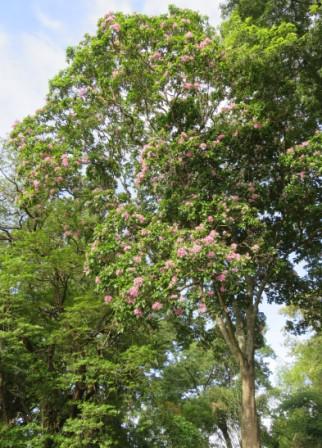
Calodendrum capense Photo by Rob Jarvis
Tree of The Month, Calodendron capense
By Rob Jarvis
This is one of the most beautiful forest trees and it occurs in Zimbabwe and most neighbouring countries. They often stand out in a forest as the only bright colour in a sea of green. Unfortunately cameras usually fail to catch the exquisite colours of the flowers, which are a light pink or lilac-pink and you really have to grow your own tree in the garden to truly appreciate them.
Ours on the left grows in a little patch of forest we have next to the main gate of our family residence and we usually forget we have it until we see it flowering profusely at this time of year. The tree was already there when we took up residence in 1980 and we did not find out from the previous owners whether they had planted it or if it was already established. So at a guess, I would suspect it was planted around 1972 and has therefore just passed its 50th anniversary. The main stem has a deeply convoluted appearance and is greeny-brown in colour and true to the type description the tree has a single stem growing very straight, which one would expect from a forest-dweller.
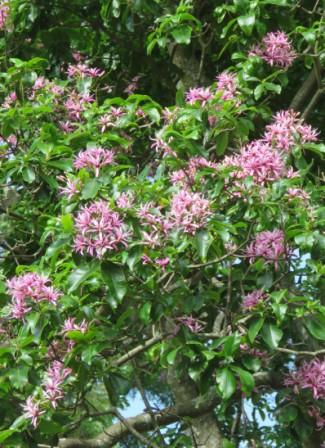
Calodendrum capense Photo by Rob Jarvis
They make excellent specimen or shade trees and really should be included in every medium to large garden in suburban Zimbabwe. I just wish I had planted a few more around the property years ago because of the vibrant colour they bring to the forest greenery.
In mature forests they can grow up to 20 metres tall but in our case it is probably only about 8 metres or so.
There is absolutely no doubt that the tree lives up to the original Greek, literal translation of its Latin name.
Calo– Beautiful
dendron: tree
capense: from the Cape
The Importance of Trees
by Tony Alegria
On our website under the menu item “About Us” we have the aims of our Society listed as:
THE SOCIETY AIMS
- To bring together people who are interested in trees.
- To collect, and encourage collection of, all forms of information relating to trees and to publish it both in a monthly newsletter and on the Tree Society’s Facebook page.
- To create an awareness amongst the public of the importance to human existence of trees in our landscape. See Importance of Trees.
- To promote protection of the indigenous woody vegetation of Zimbabwe and to foster its proper management.
- To co-operate with any organisation that has any of the above objectives.
After having thought about it for a while and having discussed the aims with the committee, I added a new page to the website. I’d like to think that it sort of addresses the third bullet and perhaps a bit of the fourth bullet – you be the judge! The new page which is under “Discover Trees” reads as follows:
The Importance of Trees
Trees take in carbon dioxide and produce the oxygen we breathe. In so doing they extract the carbon from the atmosphere and become carbon sinks. Roots and leaves as well as stems/branches store the carbon.
If there are enough trees, the carbon levels in the atmosphere will decrease thereby reducing the climate warming potential. However trees also decrease other airborne pollutants such as carbon monoxide, sulphur dioxide and nitrogen dioxide, but not only that, they also filter the air by removing dust resulting in better air quality which reduces asthma and allergies. Of course any other plant that photosynthesizes has the same effect but not to the same extent as they have far fewer leaves e.g. grasses.
However trees also increase water quality as they slow down storm water runoff which then allows the water to soak into the ground. They also reduce erosion which results in less silt particles being blown or carried into rivers and dams. Water which has soaked into the ground is filtered and therefore will be released slowly as clean water into rivers and streams.
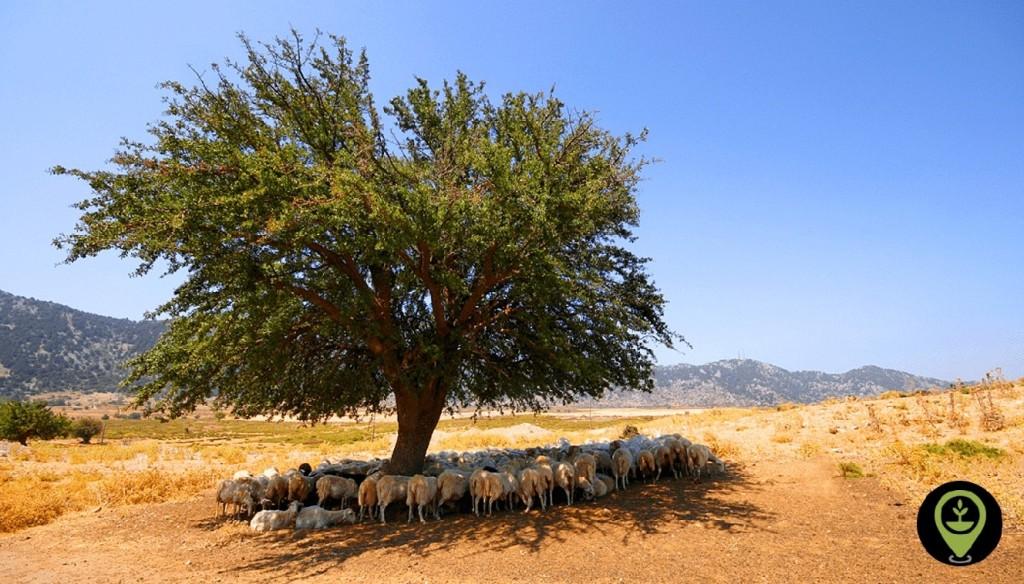
Photo from: https://www.ecomatcher.com/
However, because leaves reduce the speed of the rain falling in a forest and also shield the forest from strong winds, hail and rain, it will be warmer under the trees. Very much like a thatched building – cool in summer and warm in winter. Thus trees work all year round by moderating the extremes in temperatures.
Trees are being used more and more in the cities to reduce the heat island effect caused by the pavements, roads and all the buildings. Heat islands absorb the heat from the sun during the day and then radiate the heat at night thus keeping the temperature up.
Below ground, the roots hold the soil and help increase the ground water supply and increase soil nitrogen from leguminous trees. They also fight erosion and landslides by holding the soil together. The Eastern Highlands had a drastic erosion situation caused by the lack of trees during Cyclone Idai. Trees absorb and store rainwater thereby reducing runoff and sediment deposit after storms. This will reduce the amount of chemicals going into streams and rivers.
The leaves make compost which acts as a mulch, enrich the soil, slow down runoff and therefore retain the water for the trees and grass.
Trees provide animal fodder in the form of leaves, flowers, pods and fruit. Man also enjoys many of the fruits and edible leaves. Many life forms use the tree as their home which improves pest control as they attract toads, lizards, birds and spiders which prey on crop-eating insects. The leaves that have fallen also attract insect life and their predators. Trees maintain and even increase biodiversity.
Many trees have medicinal qualities which are used by the pharmaceutical industry to manufacture drugs. N’angas also use many medicinal parts of trees and herbs to treat people. Trees affect us psychologically as a result of the relaxed, comfortable feeling experienced when walking in a forest or woodland area.
The scents and aromas from trees also create a positive emotional response. Man is naturally attracted to the trees for camping, hiking, birdwatching, picnicking and for socializing. Trees hold cultural and spiritual value.
Wood was the very first fuel used for cooking and heating and is still very much in use today. Trees provide timber for the building trade, for making furniture, manufacturing tools, sporting equipment and many household items. They also provide firewood, charcoal, poles for building, bark rope & string. Paper is made from trees. Trees also provide bee-keeping and honey production opportunities.
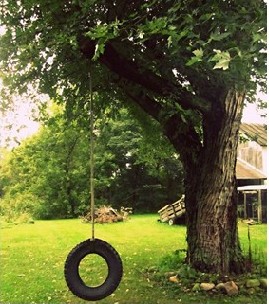
Image from pinterest.com
The value of a home is increased if trees are present and the sentimental value of a special tree is simply immeasurable. How many trees are planted to commemorate a special event?
In conclusion, trees beautify our surroundings, purify our air and water, act as sound barriers, manufacture precious oxygen, store carbon and maintain biodiversity. They help us save energy through their cooling shade in summer and their wind reduction in winter.
We should be planting trees at every opportunity and safeguarding them for our very existence. Trees have many uses and can be harvested in a sustainable manner.
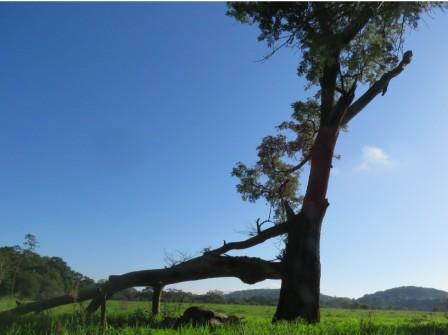
Acacia polyacantha Photo by Rob Jarvis
On the right we see a large Acacia polyacantha standing alone in a fallow field at Kent Estates near Norton. Undoubtedly this tree once stood shoulder to shoulder in a grove with others, but once left alone it could no longer carry its weaker stem and this fell to the ground. Fallen trees and stems make good homes for all manner of wildlife.
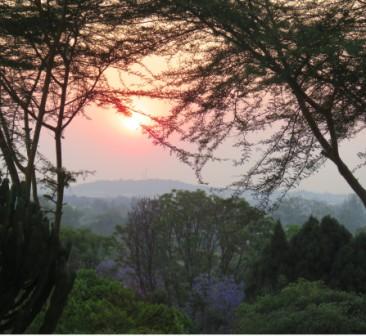
Trees make excellent frames
Photo Rob Jarvis
Bits and Bobs
By Rob Jarvis
Bits and Bobs Photo by Rob JarvisMost of us, even though we may be advocates for indigenous trees to be the main types that we see in our gardens, parks and farmlands, I am sure we all have a special spot in our hearts for the jacaranda. We were surprised therefore to see a whole hillside on Kent Estates in Norton having a broad swathe of self-sown jacarandas flowering around Christmas Day. September/October is the usual time for them to burst into their purple floral song, but it appears these trees on a hillside on Kent are beating their own drums. Long may it last.
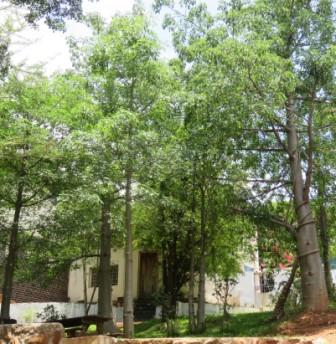
Bits and Bobs Photo by Rob Jarvis
On the left we see a small baobab forest we planted out some years ago on a property in Hillside, Harare, about 1 kilometre away from Mukuvisi Woodlands. The tree you can see with a dark stem on the left third of the picture has flowered this year for the second time only in its career and it flowered profusely. No fruits as far as we can see but maybe if the tree starts to flower every year, the pollinators and consequent fertilised fruits, will come. We deliberately planted these trees in fairly close proximity in the hope that over time some of the stems will fuse together and give us giant specimens like those to be found in the Lowveld.
On the right of the photo you can see a Fockea liane aggressively climbing up the largest baobab. Both plants appear very happy.
TREE SOCIETY COMMITTEE AND CONTACTS
Chairman Tony Alegria tonyalegria47@gmail.com 0772 438 697
Vice Chairman Rob Jarvis bo.hoom52@yahoo.com 0783 383 214
Honorary Treasurer Bill Clarke wrc@mweb.co.zw 0772 252 720
Projects Jan van Bel jan_vanbel@yahoo.com 0772 440 287
Venue Organiser Ann Sinclair jimandannsincs@zol.co.zw 0772 433 125
Tree of the Month Ryan Truscott ryan.kerr.truscott@gmail.com 0772 354 144
Secretary Teig Howson teig.howson@gmail.com 0772 256 364
Tree Society Website https://treesociety.org.zw/
Tree Society Facebook https://www.facebook.com/groups/ztreesociety/
Flora of Zimbabwe: https://www.zimbabweflora.co.zw/
Flora of Tropical Africa: https://plants.jstor.org/collection/FLOTA
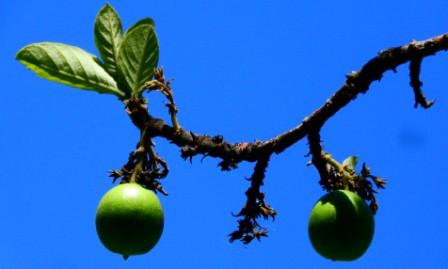
Blue sky Photo by Jim Dryburgh


